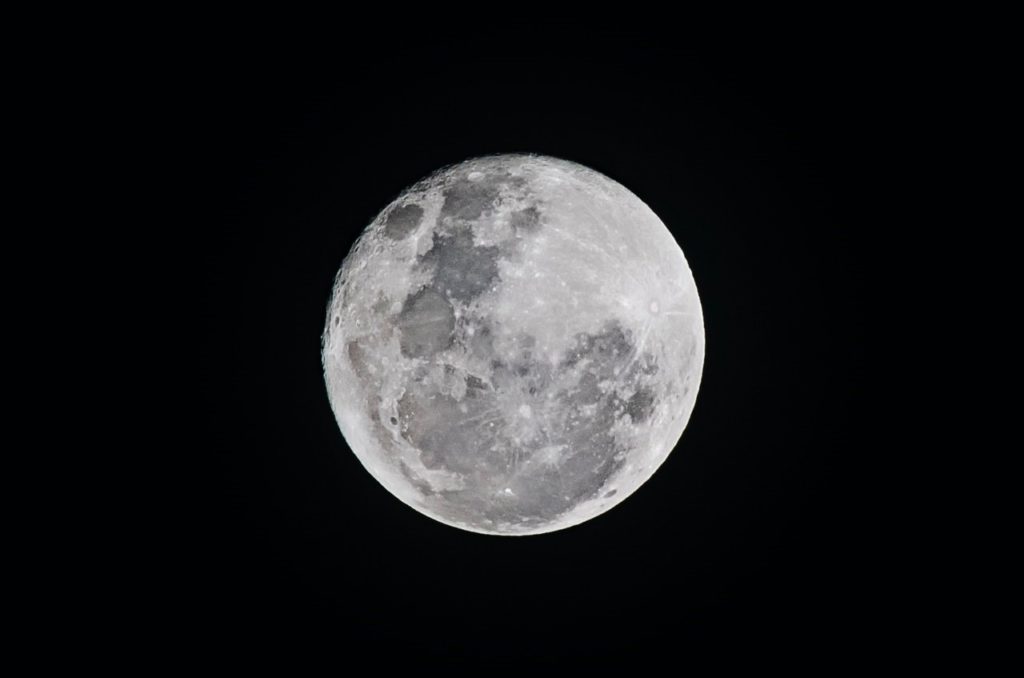
I learned this today. The moon is moving away from Earth at a rate of 3.78cm per year, but there will be a time when it will stop moving away and then it will start to fall in towards Earth. However, we are talking about a hundred billion years.
The moon has been dated to be 50 million years younger than the solar system. There are several theories for how it formed, but the most common, and the most likely, is that it was formed when a planet in the early solar system about the size of Mars hit the proto-Earth. The impact would have pulverized both and sent a huge amount of debris out into orbit around Earth. This would have formed rings that slowly coalesced into the moon.
When it was formed, the moon would have been much closer to Earth than it is now. It probably orbited at about 32,000 km and would have appeared enormous in the sky. That 32,000 km is safely outside Earth’s Roche limit for the moon, which is 18,470 km. The Roche limit is the point where the gravity of Earth would overcome the moon’s own gravity and rip it to pieces. Every single body in space has a Roche limit that gets further away the larger the body is. The Roche limit depends on the size of the two bodies. For example, the Roche limit for the sun and Earth is 556,397km. If Earth gets closer than that to the sun, it will be ripped to shreds. Although, the heat of the sun would burn Earth up long before that.
Since it was formed, the moon has been moving away from Earth at 3.78cm per year. It moves away because Earth is constantly trying to fling the moon off into space. Earth spins much faster than the moon orbits and it drags the moon with it. This drag causes the tides on Earth. The drag that the moon causes on Earth also slows down Earth’s rotation by 1.8 milliseconds every 100 years. When Earth was only 600 million years old, a day was about 22 hours long because Earth span faster than it does now. The drag of the moon on Earth balances out the force with which Earth is trying to fling the moon away and they almost counter each other out. Almost being that 3.78 cm a year. Earth has pushed the moon away by about 350,000 km and the moon has slowed Earth’s rotation to its current 24 hours a day (23 hours 56 minutes 4 seconds).
So, what will happen in the future? Earth will keep pushing the moon away and the moon will keep slowing down Earth’s speed of rotation. There will come a point where the Earth’s rotation has been slowed to the same speed as the moon’s orbital speed and they will become tidally locked. That means one side of the moon will always face one side of Earth. At this time, which will probably be in about 15 billion years, the moon will take 47 days to orbit Earth and Earth’s rotation will have slowed so much that Earth will rotate once every 47 days as well.
Once the two bodies have become locked, Earth will not be rotating enough to push the moon away and its gravity will start to pull the moon back. The speed with which the moon is reeled in will slowly pick up as it gets closer, until it reaches the Roche limit and is ripped to pieces. This is what will theoretically happen. It will not really happen, though because it would take over 100 billion years for all of this to happen and our sun will become a red giant in about 5 billion years.
A red giant is when a star has converted all of its hydrogen into helium and a huge sphere of hot gas called a photosphere extends out from it. In about 5 billion years, this hot gas will reach the moon and cause a lot of drag, slowing it down and making it spiral in towards Earth. It will reach the Roche limit, get torn to pieces and become a ring around Earth. The pieces of this ring will rain down on Earth. Then the sun will expand even more and Earth will be pulled into the sun, burning up.
So, the moon is moving away from Earth at 3.78cm a year, but it is also slowing Earth’s rotation down. In 15 billion years the moon and Earth will have become tidally locked and in 100 billion years the moon will be pulled back into Earth. However, the sun will have become a red giant long before then and made all of this a moot point. And that is what I learned today.
Sources:
https://en.wikipedia.org/wiki/Moon
https://en.wikipedia.org/wiki/Giant-impact_hypothesis
https://www.theatlantic.com/science/archive/2021/09/moon-moving-away-earth/620254/
https://english.stackexchange.com/questions/326641/the-earth-vs-earth
https://www.space.com/3373-earth-moon-destined-disintegrate.html
https://www.discovermagazine.com/planet-earth/the-earths-rotation-is-gradually-slowing-down
